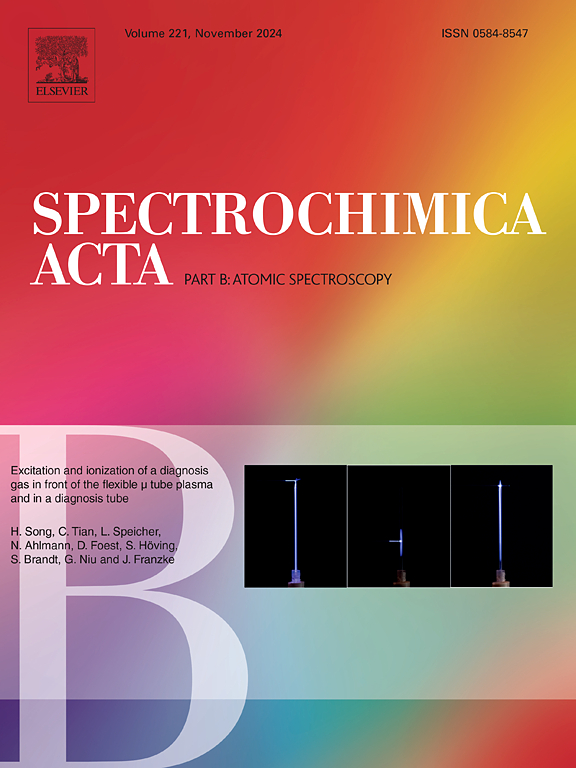LIBS for soil analysis: Effects of sample heating and high-voltage re-excitation on plasma characteristics
IF 3.8
2区 化学
Q1 SPECTROSCOPY
引用次数: 0
Abstract
While LIBS is a proven technique for monitoring elemental traces in soils, its signal-to-noise ratio is lower than comparable methods. Enhancement techniques such as sample heating and applying a high-voltage (HV) discharge have shown potential to increase emission and improve LIBS sensitivity. This study investigates the combined effect of these techniques on plasma morphology, physical parameters, and the validity of local thermodynamic equilibrium (LTE). Plasma was produced by a nanosecond Nd:YAG laser beam focused on loam soil samples at 22 and 400 °C. A high-voltage discharge lasting about 10 μs was applied 1.5 μs after the laser irradiation. Plasma morphology was studied using fast photography; electron density was obtained through Stark broadening and temperature from Saha-Boltzmann plots, both with spatial and temporal resolution. LTE was tested by McWhirter criterion and two criteria for nonhomogeneous and transient plasmas. Results showed that sample heating doubled plasma lifetime and increased emission, while the HV discharge enhanced emission but induced turbulence, accelerating plasma disruption. Plasma temperature increased by 16 % when the discharge was applied while an increment of 10 % was obtained with sample heating alone; electron density rose by 80 % in both cases. Combining both techniques, the temperature increased by approximately 20 % and electron density by 130 %. Along the axial direction, increases were almost uniform. Radially, higher increases occurred near the cathode. The differential displacement of the ion and neutral clouds suggests that the HV discharge induced species polarization. LTE criteria were satisfied for all studied scenarios, in the range from 500 nm to 10 μs, after the laser onset. Our findings suggest that increased electron density and temperature result in the enhanced spectral emission observed. Finally, a laser-induced plasma may sustain LTE even under re-excitation or external perturbations.

LIBS用于土壤分析:样品加热和高压再激发对等离子体特性的影响
虽然LIBS是一种经过验证的监测土壤中元素痕迹的技术,但其信噪比低于可比方法。增强技术,如样品加热和施加高压(HV)放电,已经显示出增加发射和提高LIBS灵敏度的潜力。本研究探讨了这些技术对等离子体形态、物理参数和局部热力学平衡(LTE)有效性的综合影响。用纳秒Nd:YAG激光束聚焦在22°C和400°C的壤土样品上产生等离子体。在激光照射后1.5 μs施加持续约10 μs的高压放电。采用快速摄影技术研究等离子体形态;在Saha-Boltzmann图上通过Stark展宽和温度得到电子密度,具有空间分辨率和时间分辨率。LTE采用McWhirter准则和非均匀等离子体和瞬态等离子体两个准则进行测试。结果表明:样品加热使等离子体寿命增加了一倍,并增加了发射,而高压放电增强了发射,但引起湍流,加速了等离子体的破坏。放电时,等离子体温度升高16%,而单独加热样品时,等离子体温度升高10%;在这两种情况下,电子密度都提高了80%。结合这两种技术,温度提高了大约20%,电子密度提高了130%。沿轴向,增加几乎是均匀的。从径向上看,阴极附近的增加幅度较大。离子云和中性云的位移差表明高压放电引起了物质极化。在500 nm至10 μs范围内,激光照射后的所有场景均满足LTE标准。我们的研究结果表明,电子密度和温度的增加导致了光谱发射的增强。最后,激光诱导等离子体即使在再激发或外部扰动下也可以维持LTE。
本文章由计算机程序翻译,如有差异,请以英文原文为准。
求助全文
约1分钟内获得全文
求助全文
来源期刊
CiteScore
6.10
自引率
12.10%
发文量
173
审稿时长
81 days
期刊介绍:
Spectrochimica Acta Part B: Atomic Spectroscopy, is intended for the rapid publication of both original work and reviews in the following fields:
Atomic Emission (AES), Atomic Absorption (AAS) and Atomic Fluorescence (AFS) spectroscopy;
Mass Spectrometry (MS) for inorganic analysis covering Spark Source (SS-MS), Inductively Coupled Plasma (ICP-MS), Glow Discharge (GD-MS), and Secondary Ion Mass Spectrometry (SIMS).
Laser induced atomic spectroscopy for inorganic analysis, including non-linear optical laser spectroscopy, covering Laser Enhanced Ionization (LEI), Laser Induced Fluorescence (LIF), Resonance Ionization Spectroscopy (RIS) and Resonance Ionization Mass Spectrometry (RIMS); Laser Induced Breakdown Spectroscopy (LIBS); Cavity Ringdown Spectroscopy (CRDS), Laser Ablation Inductively Coupled Plasma Atomic Emission Spectroscopy (LA-ICP-AES) and Laser Ablation Inductively Coupled Plasma Mass Spectrometry (LA-ICP-MS).
X-ray spectrometry, X-ray Optics and Microanalysis, including X-ray fluorescence spectrometry (XRF) and related techniques, in particular Total-reflection X-ray Fluorescence Spectrometry (TXRF), and Synchrotron Radiation-excited Total reflection XRF (SR-TXRF).
Manuscripts dealing with (i) fundamentals, (ii) methodology development, (iii)instrumentation, and (iv) applications, can be submitted for publication.

 求助内容:
求助内容: 应助结果提醒方式:
应助结果提醒方式:


